Overstory–Understory Vegetation Cover and Soil Water Content Observations in Western Juniper Woodlands: A Paired Watershed Study in Central Oregon, USA
Abstract
:1. Introduction
2. Materials and Methods
2.1. Description of Study Site
2.2. Field Data Collection of Vegetation and Soil Properties
2.3. Data Analysis
3. Results
3.1. Vegetation
3.2. Soil Water Content
3.2.1. Soil Water Content by Month and by Aspect
3.2.2. Spatial Distribution of Soil Water Content
3.2.3. Canopy Cover and Clay Content Effects on Soil Water Content
4. Discussion
5. Conclusions
Author Contributions
Acknowledgments
Conflicts of Interest
Appendix
| Soil Type | n | Sand (%) | Clay (%) | Silt (%) | θFC (%) | θPWP (%) | AWC (%) |
|---|---|---|---|---|---|---|---|
| Sandy Loam | 877 | 73.5 | 15.9 | 10.6 | 25.0 | 12.5 | 12.5 |
| Sandy Clay Loam | 340 | 66.8 | 22.2 | 11.1 | 29.1 | 16.1 | 13.0 |
| Loamy Sand | 85 | 82.9 | 8.1 | 9.0 | 19.1 | 7.6 | 11.5 |
| Sand | 9 | 90.3 | 2.1 | 7.6 | 13.8 | 3.3 | 10.5 |
| Soil Type | θPWP (%) | θFC (%) | AWC (%) |
|---|---|---|---|
| Sandy Loam | |||
| Petersen et al. 1968 [33] | 13 | 25 | 12 |
| Bruand et al. 1994 [32] | 12 | 20 | 8 |
| Santra et al. 2018 [34] | 9 | 15 | 6 |
| Schaap et al. 2001 [35] | 6 | 17 | 11 |
| Sandy Clay Loam | |||
| Petersen et al. 1968 [33] | 16 | 29 | 13 |
| Bruand et al. 1994 [32] | 16 | 23 | 8 |
| Santra et al. 2018 [34] | 11 | 18 | 7 |
| Schaap et al. 2001 [35] | 8 | 21 | 13 |
| Loamy Sand | |||
| Petersen et al. 1968 [33] | 8 | 19 | 12 |
| Bruand et al. 1994 [32] | 7 | 15 | 7 |
| Santra et al. 2018 [34] | 6 | 11 | 5 |
| Schaap et al. 2001 [35] | 8 | 21 | 13 |
| Sand | |||
| Petersen et al. 1968 [33] | 3 | 14 | 10 |
| Bruand et al. 1994 [32] | 3 | 11 | 7 |
| Santra et al. 2018 [34] | 3 | 8 | 4 |
| Schaap et al. 2001 [35] | <1 | 5 | 5 |
| Aspect | n | Sand (%) | Silt (%) | Clay (%) |
|---|---|---|---|---|
| Treated watershed | ||||
| East | 79 | 72.0 | 10.5 | 17.5 |
| North | 125 | 74.0 | 9.9 | 16.1 |
| North-East | 123 | 73.5 | 10.0 | 16.5 |
| North-West | 78 | 73.3 | 10.3 | 16.4 |
| South | 45 | 75.5 | 10.0 | 14.5 |
| South-East | 48 | 74.2 | 9.8 | 16.0 |
| South-West | 79 | 74.7 | 9.4 | 15.9 |
| West | 77 | 72.7 | 10.6 | 16.7 |
| Untreated watershed | ||||
| East | 35 | 71.3 | 11.2 | 17.6 |
| North | 80 | 71.4 | 10.2 | 18.4 |
| North-East | 176 | 71.1 | 11.3 | 17.6 |
| North-West | 116 | 70.5 | 12.0 | 17.5 |
| South | 21 | 75.3 | 8.9 | 15.8 |
| South-East | 56 | 71.1 | 10.6 | 18.3 |
| South-West | 87 | 73.4 | 11.0 | 15.6 |
| West | 70 | 73.1 | 10.7 | 16.2 |
References
- Huxman, T.E.; Wilcox, B.P.; Breshears, D.D.; Scott, R.L.; Snyder, K.A.; Small, E.E.; Hultine, K.; Pockman, W.T.; Jackson, R.B. Ecohydrological implications of woody plant encroachment. Ecology 2005, 86, 308–319. [Google Scholar] [CrossRef]
- Owens, M.K.; Lyons, R.K.; Alejandro, C.L. Rainfall partitioning within semiarid juniper communities: Effects of event size and canopy cover. Hydrol. Process. 2006, 20, 3179–3189. [Google Scholar] [CrossRef]
- Yager, L.Y.; Smeins, F.E. Ashe Juniper (Juniperus ashei: cupressaceae) canopy and litter effects on understory vegetation in a juniper-oak savanna. Southwest Nat. 1999, 44, 6–16. [Google Scholar]
- Pierson, F.B.; Williams, C.J.; Kormos, P.R.; Al-Hamdan, O.Z. Short-term effects of tree removal on infiltration, runoff, and erosion in woodland-encroached sagebrush steppe. Rangel. Ecol. Manag. 2014, 67, 522–538. [Google Scholar] [CrossRef]
- Wilcox, B.P.; Thurow, T.L. Emerging issues in rangeland ecohydrology: Vegetation change and the water cycle. Rangel. Ecol. Manag. 2006, 59, 220–224. [Google Scholar] [CrossRef]
- Zou, C.B.; Turton, D.J.; Will, R.E.; Engle, D.M.; Fuhlendorf, S.D. Alteration of hydrological processes and streamflow with juniper (Juniperus virginiana) encroachment in a mesic grassland catchment. Hydrol. Process. 2014, 28, 6173–6182. [Google Scholar] [CrossRef]
- Breshears, D.D.; Myers, O.B.; Johnson, S.R.; Meyer, C.W.; Martens, S.N. Differential use of spatially heterogeneous soil moisture by two semiarid woody species: Pinus edulis and Juniperus monosperma. J. Ecol. 1997, 85, 289–299. [Google Scholar] [CrossRef]
- Madsen, M.D.; Chandler, D.G.; Belnap, J. Spatial gradients in ecohydrologic properties within a pinyon-juniper ecosystem. Ecohydrology 2008, 1, 349–360. [Google Scholar] [CrossRef]
- McCole, A.A.; Stern, L.A. Seasonal water use patterns of juniperus ashei on the Edwards Plateau, Texas, based on stable isotopes in water. J. Hydrol. 2007, 342, 238–248. [Google Scholar] [CrossRef]
- Buckhouse, J.C.; Gaither, R.E. Potential sediment production within vegetative communities in Oregon’s Blue Mountains. J. Soil Water Conserv. 1982, 37, 120–122. [Google Scholar]
- Pierson, F.B.; Williams, C.J.; Kormos, P.R.; Hardegree, S.P.; Clark, P.E.; Rau, B.M. Hydrologic vulnerability of sagebrush steppe following pinyon and juniper encroachment. Rangel. Ecol. Manag. 2010, 63, 614–630. [Google Scholar] [CrossRef]
- Urgeghe, A.M.; Breshears, D.D.; Martens, S.N.; Beeson, P.C. Redistribution of runoff among vegetation patch types: On ecohydrological optimality of herbaceous capture of run-on. Rangel. Ecol. Manag. 2010, 63, 497–504. [Google Scholar] [CrossRef]
- Cowlin, R.W.; Briegleb, P.A.; Moravets, F.L. Forest resources of the ponderosa pine region of Washington and Oregon; U.S. Department of Agriculture, Forest Service: Washington, DC, USA, 1942; p. 122.
- Azuma, D.L.; Hiserote, B.A.; Dunham, P.A. The Western Juniper Resource of Eastern Oregon; U.S. Department of Agriculture, Forest Service, Pacific Northwest Research Station: Portland, OR, USA, 2005; p. 18.
- Miller, R.; Rose, J. Historic expansion of Juniperus occidentalis (western juniper) in southeastern Oregon. Gt. Basin Nat. 1995, 55, 37–45. [Google Scholar]
- Dittel, J.W.; Sanchez, D.; Ellsworth, L.M.; Morozumi, C.N.; Mata-Gonzalez, R. Vegetation response to juniper reduction and grazing exclusion in sagebrush-steppe habitat in eastern Oregon. Rangel. Ecol. Manag. 2018, 71, 213–219. [Google Scholar] [CrossRef]
- Mollnau, C.; Newton, M.; Stringham, T. Soil water dynamics and water use in a western juniper (Juniperus occidentalis) woodland. J. Arid Environ. 2014, 102, 117–126. [Google Scholar] [CrossRef]
- Petersen, S.L.; Stringham, T.K. Infiltration, runoff, and sediment yield in response to western juniper encroachment in southeast Oregon. Rangel. Ecol. Manag. 2008, 61, 74–82. [Google Scholar] [CrossRef]
- Pierson, F.B.; Bates, J.D.; Svejcar, T.J.; Hardegree, S.P. Runoff and erosion after cutting western juniper. Rangel. Ecol. Manag. 2007, 60, 285–292. [Google Scholar] [CrossRef]
- Ffolliott, P.F.; Gottfried, G.J. Hydrologic Processes in the Pinyon-Juniper Woodlands: A Literature Review; U.S. Department of Agriculture, Forest Service, Rocky Mountain Research Station: Fort Collins, CO, USA, 2012.
- Miller, R.F.; Bates, J.D.; Svejcar, T.J.; Pierson, F.B.; Eddleman, L.E. Biology, Ecology, and Management of Western Juniper (Juniperus occidentalis); Oregon State University: Corvallis, OR, USA, 2005. [Google Scholar]
- Wilcox, B.P.; Downhower, S.L.; Teague, R.W.; Thurow, T.L. Long-term water balance in a semiarid shrubland. Rangel. Ecol. Manag. J. Range Manag. Arch. 2006, 59, 600–606. [Google Scholar] [CrossRef]
- Deboodt, T.L. Watershed Response to Western Juniper Control. Ph.D. Thesis, Oregon State University, Corvallis, OR, USA, May 2008. [Google Scholar]
- Fisher, M. Analysis of Hydrology and Erosion in Small, Paired Watersheds in a Juniper-Sagebrush Area of Central Oregon. Ph.D. Thesis, Oregon State University, Corvallis, OR, USA, September 2004. [Google Scholar]
- Ochoa, C.G.; Caruso, P.; Ray, G.; Deboodt, T.; Jarvis, W.T.; Guldan, S.J. Ecohydrologic connections in semiarid watershed systems of central Oregon USA. Water 2018, 10, 181. [Google Scholar] [CrossRef]
- Official Soil Series Descriptions (OSDs) | NRCS Soils. Available online: https://www.nrcs.usda.gov/wps/portal/nrcs/detail/soils/survey/geo/?cid=nrcs142p2_053587 (accessed on 21 January 2019).
- Anderson, E.W.; Borman, M.M.; Krueger, W.C. The Ecological Provinces of Oregon: A Treatise on the Basic Ecological Geography of the State; Oregon State University: Corvallis, OR, USA, 1998; p. 138. [Google Scholar]
- Herrick, J.E.; Van Zee, J.W.; Havstad, K.M.; Burkett, L.M.; Whitford, W.G. Monitoring Manual for Grassland, Shrubland, and Savanna Ecosystems; USDA-ARS Jornada Experimental Range: Las Cruces, NM, USA, 2005. [Google Scholar]
- Bárdossy, A.; Lehmann, W. Spatial distribution of soil moisture in a small catchment. Part 1: Geostatistical analysis. J. Hydrol. 1998, 206, 1–15. [Google Scholar] [CrossRef]
- Western, A.W.; Grayson, R.B.; Blöschl, G. Scaling of soil moisture: A hydrologic perspective. Annu. Rev. Earth Planet. Sci. 2002, 30, 149–180. [Google Scholar] [CrossRef]
- Guber, A.K.; Pachepsky, Y.A. Multimodeling with Pedotransfer Functions. Documentation and User Manual for PTF Calculator (CalcPTF) Version 3.0 2010.
- Bruand, A.; Baize, D.; Hardy, M. Prediction of water retention properties of clayey soils: Validity of relationships using a single soil characteristic. Soil Use Manag. 1994, 10, 99–103. [Google Scholar] [CrossRef]
- Petersen, G.W.; Cunningham, R.L.; Matelski, R.P. Moisture characteristics of Pennsylvania soils: I. Moisture retention as related to texture. Soil Sci. Soc. Am. J. 1968, 32, 271–275. [Google Scholar] [CrossRef]
- Santra, P.; Kumar, M.; Kumawat, R.N.; Painuli, D.K.; Hati, K.M.; Heuvelink, G.B.M.; Batjes, N.H. Pedotransfer functions to estimate soil water content at field capacity and permanent wilting point in hot Arid Western India. J. Earth Syst. Sci. 2018, 127. [Google Scholar] [CrossRef]
- Schaap, M.G.; Leij, F.J.; van Genuchten, M.T. Rosetta: A computer program for estimating soil hydraulic parameters with hierarchical pedotransfer functions. J. Hydrol. 2001, 251, 163–176. [Google Scholar] [CrossRef]
- Abdallah, M.A.B.; Mata-Gonzalez, R.; Martin, D.W.; Noller, J.S.; Wan, C. Consequences of surface and subsurface water use of wetland graminoids of different geographic origin. Wetlands 2017, 38, 121–131. [Google Scholar] [CrossRef]
- Williams, C.J.; Snyder, K.A.; Pierson, F.B. Spatial and temporal variability of the impacts of pinyon and juniper reduction on hydrologic and erosion processes across climatic gradients in the Western US: A regional synthesis. Water 2018, 10, 1607. [Google Scholar] [CrossRef]
- Acharya, B.S.; Kharel, G.; Zou, C.B.; Wilcox, B.P.; Halihan, T. Woody plant encroachment impacts on groundwater recharge: A review. Water 2018, 10, 1466. [Google Scholar] [CrossRef]
- Bates, J.D.; Svejcar, T.; Miller, R.; Davies, K.W. Plant community dynamics 25 years after juniper control. Rangel. Ecol. Manag. 2017, 70, 356–362. [Google Scholar] [CrossRef]
- Skau, C.M. Soil Water Storage Under Natural and Cleared Stands of Alligator and Utah Juniper in Northern Arizona; U.S. Forest Service; Rocky Mountain Forest and Range Experiment Station: Fort Collins, CO, USA, 1964.
- Everett, R.L.; Sharrow, S.H. Soil Water and Temperature in Harvested and Nonharvested Pinyon-Juniper Stands; Research Paper INT 342; US Forest Service; Intermountain Research Station: Ogden, UT, USA, 1985; p. 5. [Google Scholar]
- Young, J.A.; Evans, R.A.; Easi, D.A. Stem flow on western juniper (Juniperus occidentalis) trees. Weed Sci. 1984, 32, 320–327. [Google Scholar]
- Larsen, R.E. Interception and water holding capacity of western juniper. Ph.D. Thesis, Oregon State University, Corvallis, OR, USA, August 1993. [Google Scholar]
- Måren, I.E.; Karki, S.; Prajapati, C.; Yadav, R.K.; Shrestha, B.B. Facing north or south: Does slope aspect impact forest stand characteristics and soil properties in a semiarid trans-Himalayan valley? J. Arid Environ. 2015, 121, 112–123. [Google Scholar] [CrossRef]
- Westerband, A.; Dovčiak, M.; Quay-Velázquez, G.L.; Medeiros, J.S. Aspect reduces soil moisture and tree cover, but not nitrogen mineralization or grass cover, in semiarid pinyon-juniper woodlands of the southwestern United States. Southwest. Nat. 2015, 60, 21–30. [Google Scholar] [CrossRef]
- D’Odorico, P.; Caylor, K.; Okin, G.S.; Scanlon, T.M. On soil moisture–vegetation feedbacks and their possible effects on the dynamics of dryland ecosystems. J. Geophys. Res. Biogeosci. 2007, 112. [Google Scholar] [CrossRef]
- Garduño, H.R.; Fernald, A.G.; Cibils, A.F.; VanLeeuwen, D.M. Response of understory vegetation and soil moisture to infrequent heavy defoliation of chemically thinned juniper woodland. J. Arid Environ. 2010, 74, 291–297. [Google Scholar] [CrossRef]
- Breshears, D.D.; Myers, O.B.; Barnes, F.J. Horizontal heterogeneity in the frequency of plant-available water with woodland intercanopy–canopy vegetation patch type rivals that occurring vertically by soil depth. Ecohydrology 2009, 2, 503–519. [Google Scholar] [CrossRef]
- Niemeyer, R.J.; Link, T.E.; Seyfried, M.S.; Flerchinger, G.N. Surface water input from snowmelt and rain throughfall in western juniper: Potential impacts of climate change and shifts in semi-arid vegetation. Hydrol. Process. 2016, 30, 3046–3060. [Google Scholar] [CrossRef]
- Lebron, I.; Madsen, M.D.; Chandler, D.G.; Robinson, D.A.; Wendroth, O.; Belnap, J. Ecohydrological controls on soil moisture and hydraulic conductivity within a pinyon-juniper woodland. Water Resour. Res. 2007, 43, 1–15. [Google Scholar] [CrossRef]
- Rodriguez-Iturbe, I. Ecohydrology: A hydrologic perspective of climate-soil-vegetation dynamics. Water Resour. Res. 2000, 36, 3–9. [Google Scholar] [CrossRef]
- Caylor, K.K.; D’Odorico, P.; Rodriguez-Iturbe, I. On the ecohydrology of structurally heterogeneous semiarid landscapes. Water Resour. Res. 2006, 42, 1–13. [Google Scholar] [CrossRef]
- Caruso, P; Ochoa, C.G.; Jarvis, W.T.; Deboodt, T. A hydrogeologic framework for understanding local groundwater flow dynamics in the southeast Deschutes Basin, Oregon, USA. Geosciences 2019, 9, 57. [Google Scholar] [CrossRef]
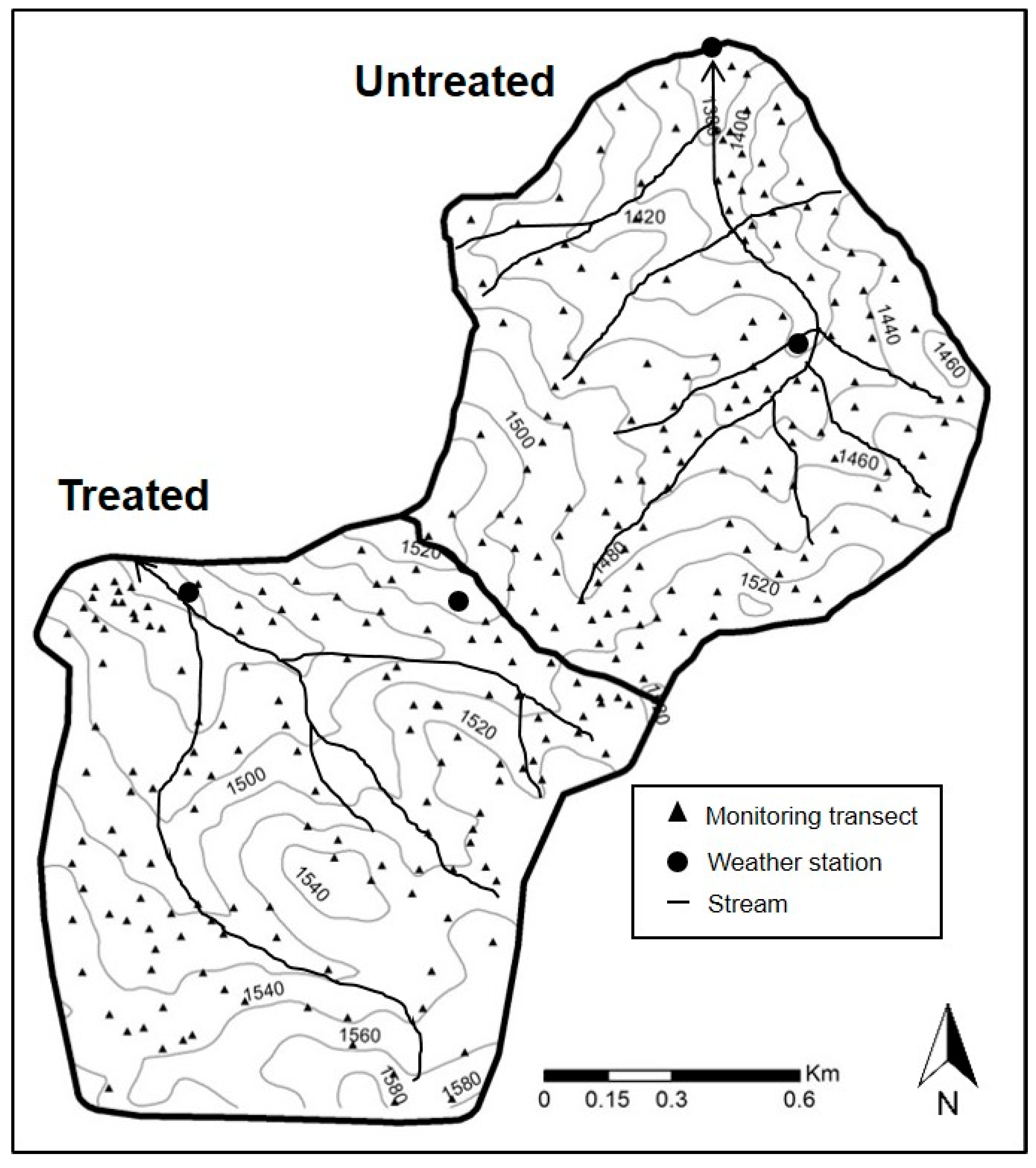
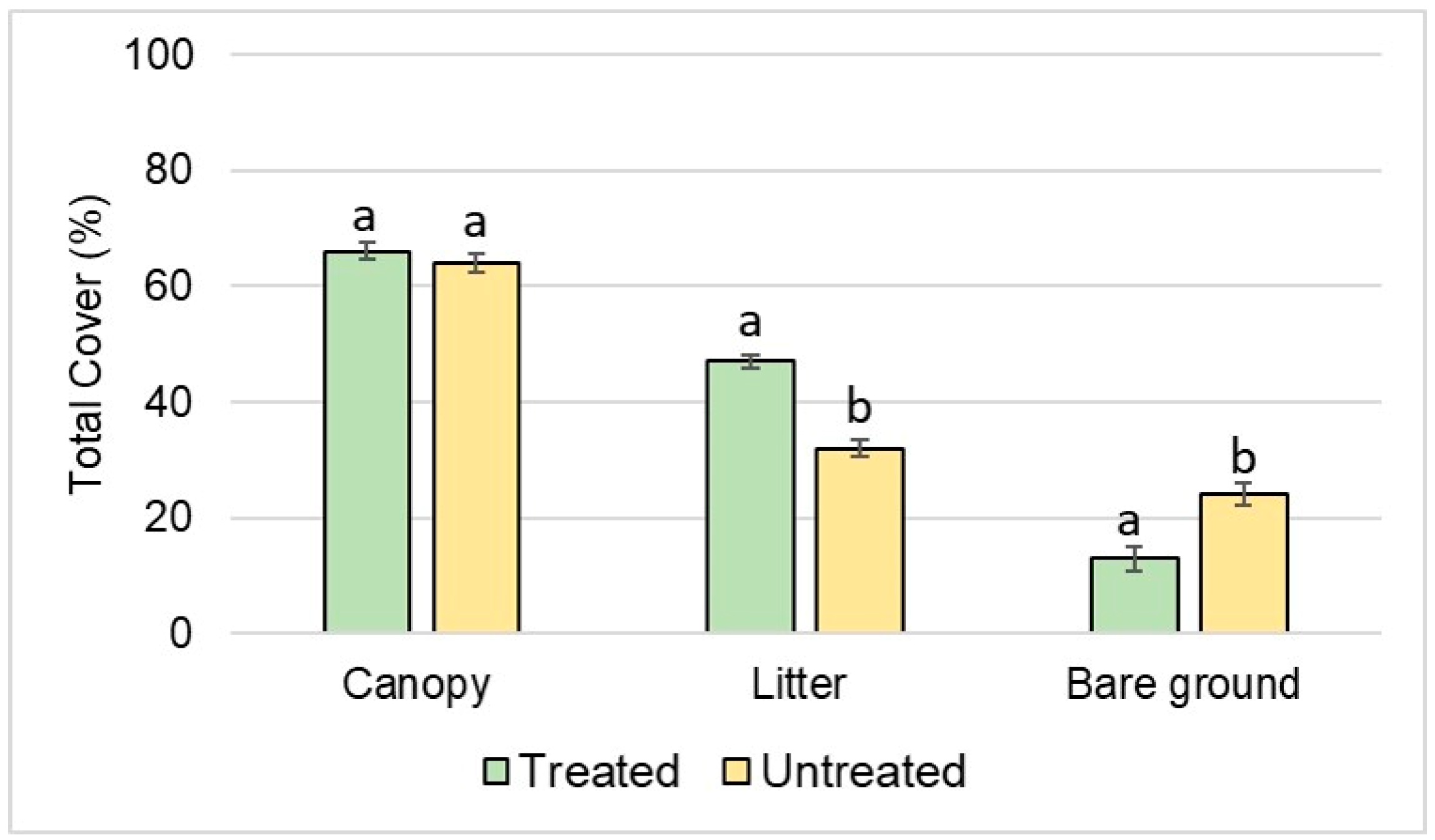
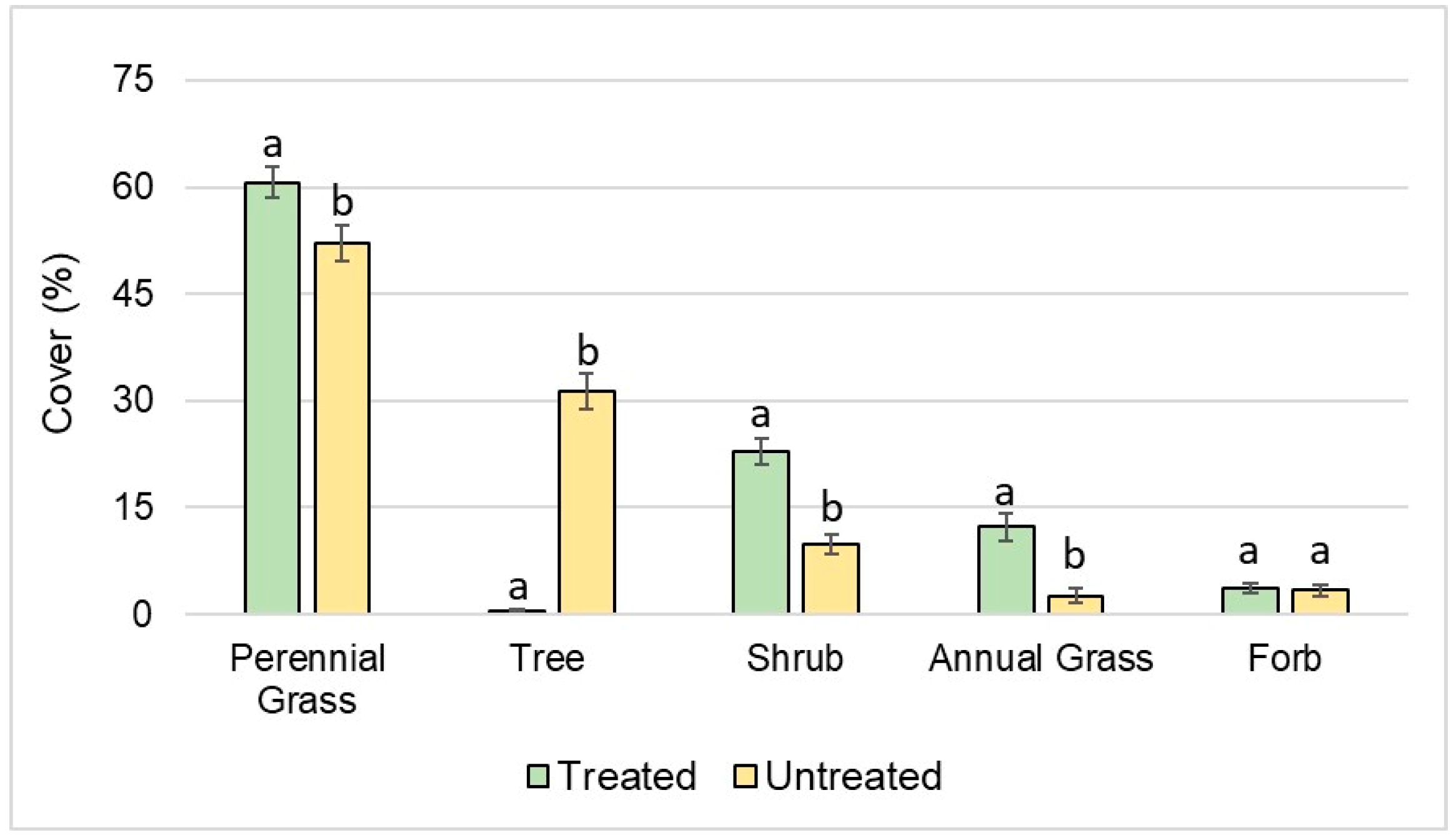
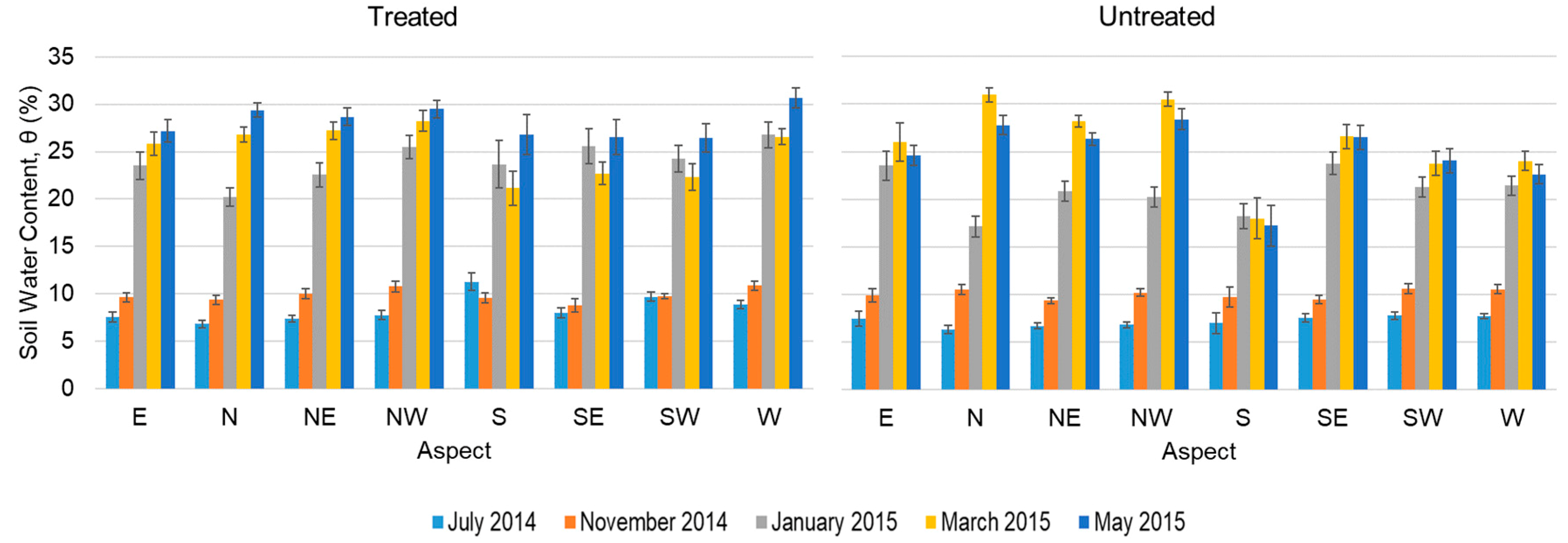
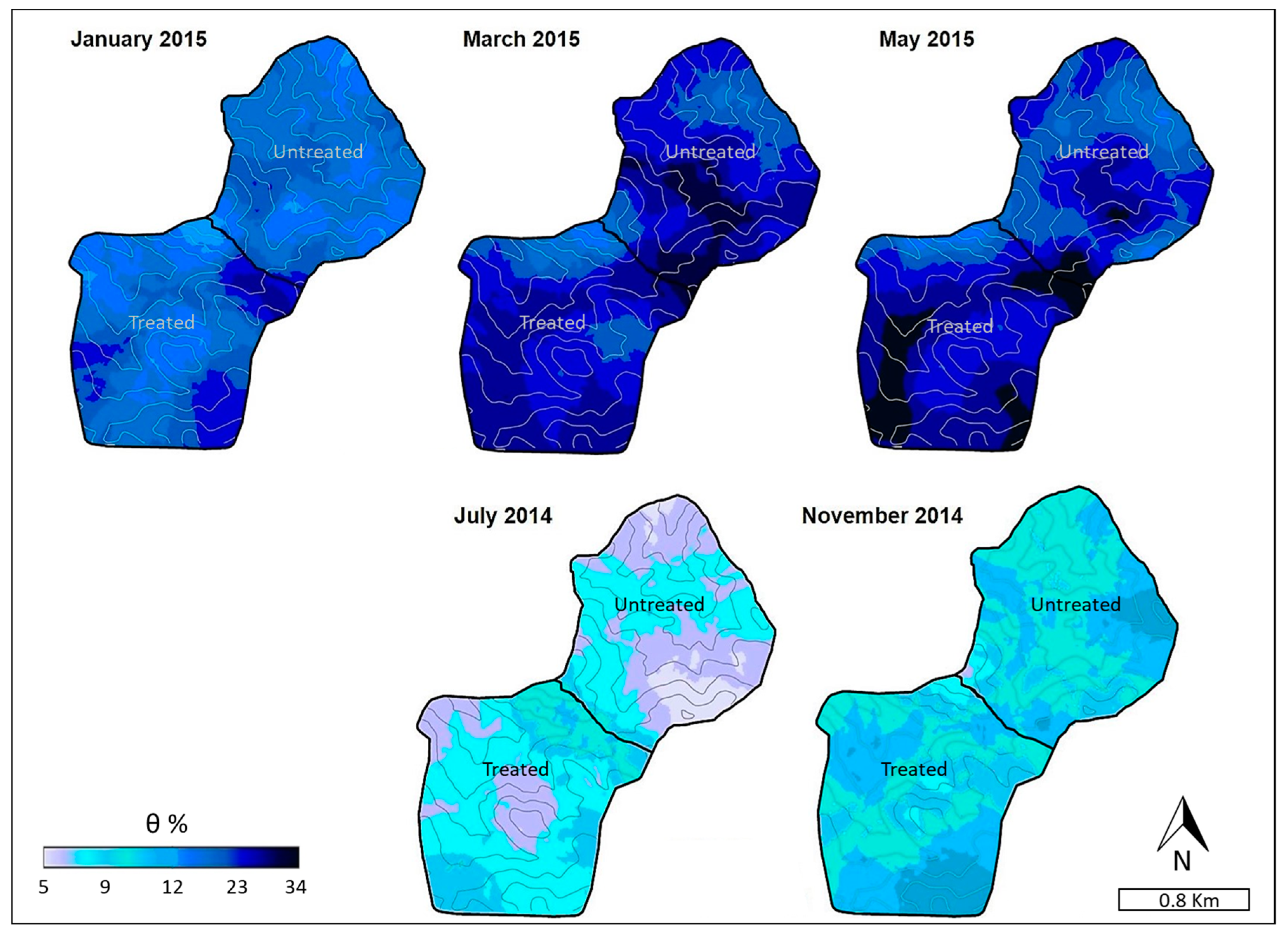
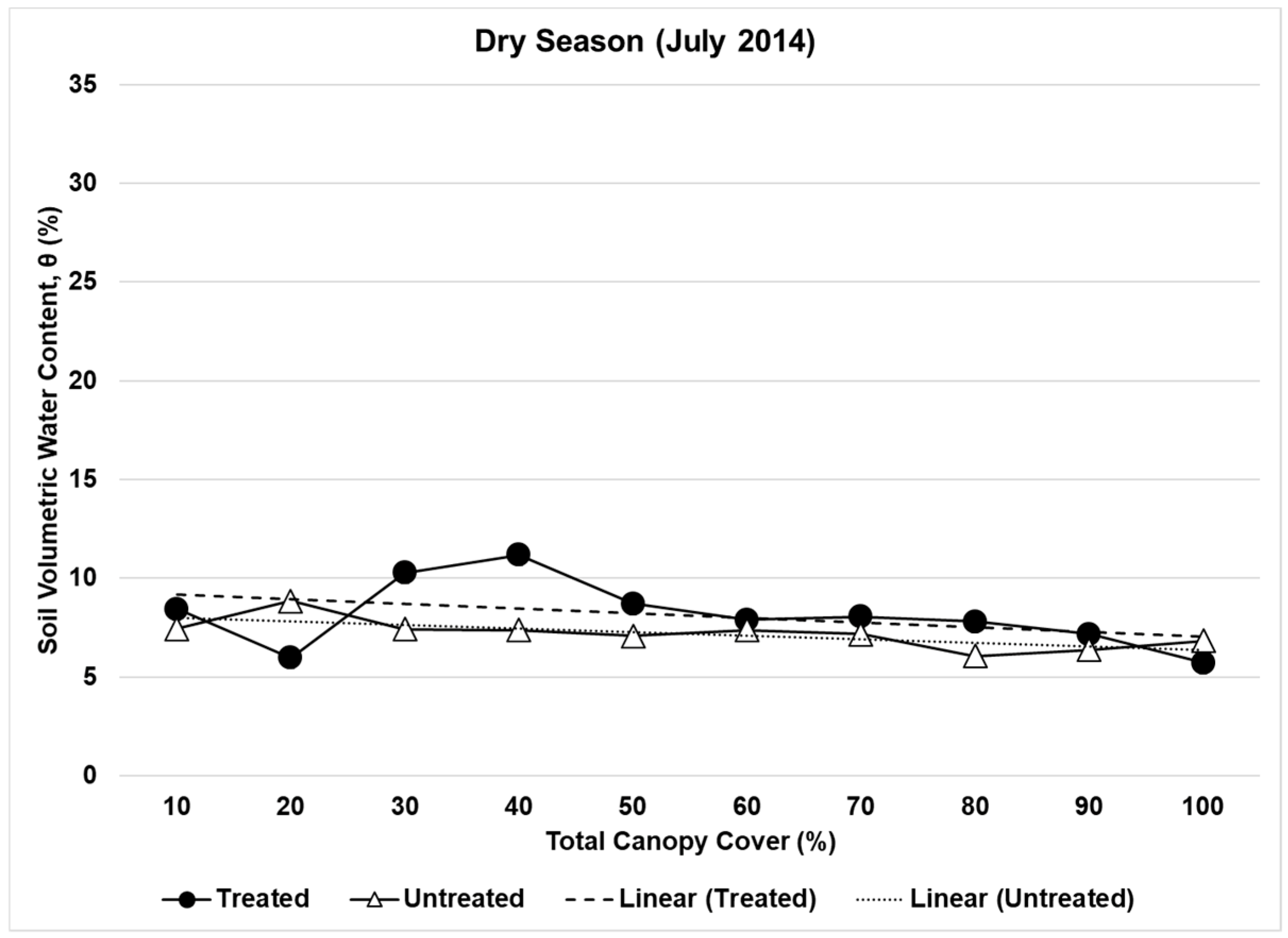
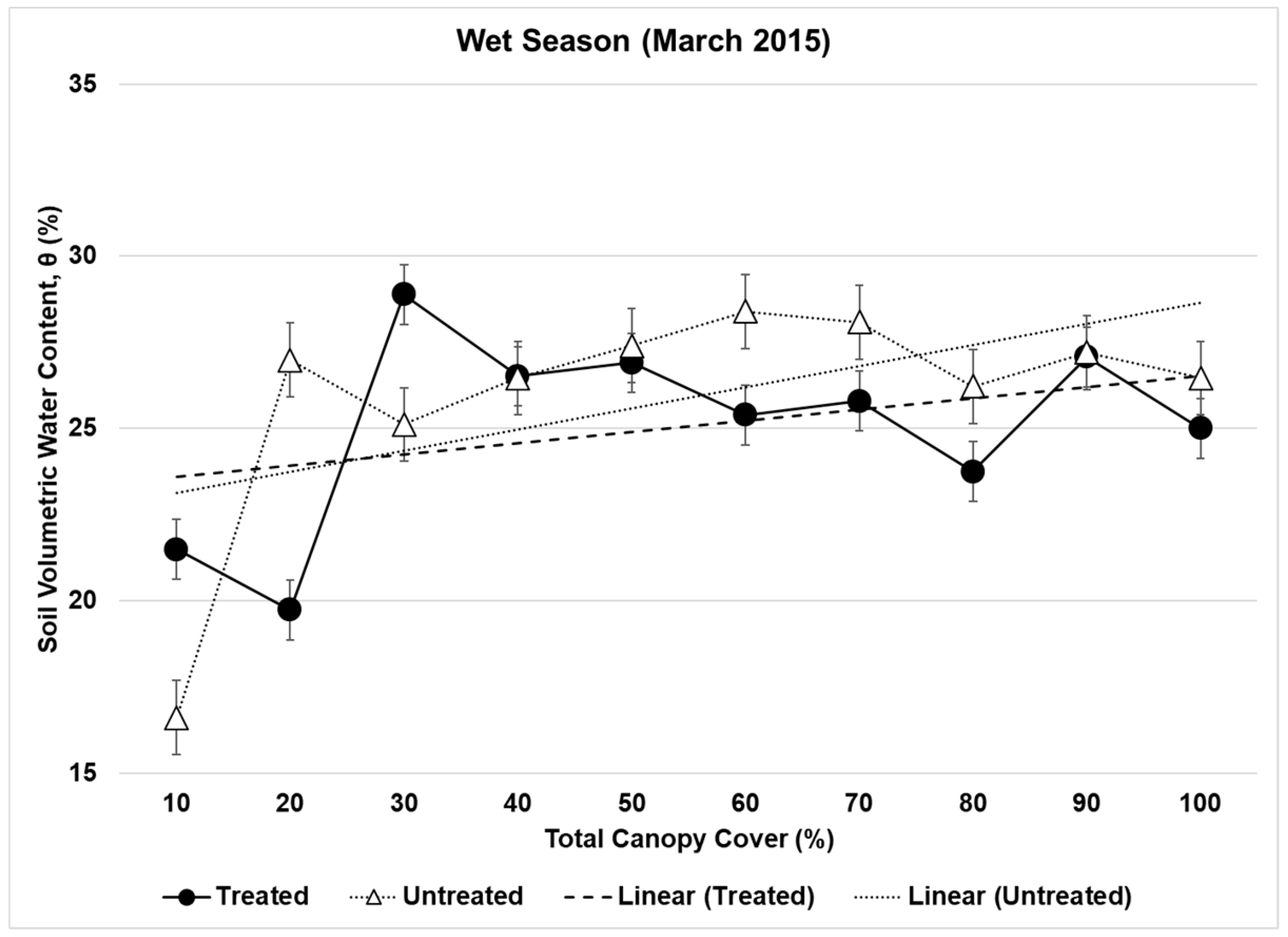
| Treated | Untreated | |||||
|---|---|---|---|---|---|---|
| θ (%) | θ (%) | |||||
| Month Year | Min | Max | Mean * | Min | Max | Mean * |
| July 2014 | 2 | 17 | 8.0 a | 3 | 12 | 7.1 b |
| November 2014 | 4 | 16 | 9.9 a | 5 | 15 | 10.0 a |
| January 2015 | 10 | 40 | 23.7 a | 9 | 37 | 20.9 b |
| March 2015 | 11 | 37 | 25.6 a | 14 | 40 | 27.2 b |
| May 2015 | 17 | 42 | 28.4 a | 12 | 41 | 25.7 b |
| Month Year | Watershed | Independent Variable | F-Value | p-Value | Estimated Trend in θ |
|---|---|---|---|---|---|
| July 2014 | Untreated | Canopy | 7.94 | 0 | − |
| Clay | NS | − | |||
| Treated | Canopy | 8.49 | 0 | − | |
| Clay | NS | + | |||
| November 2014 | Untreated | Canopy | 18.96 | 0 | − |
| Clay | NS | + | |||
| Treated | Canopy | 6.04 | 0.001 | − | |
| Clay | NS | + | |||
| January 2015 | Untreated | Canopy | 2.37 | 0.05 | − |
| Clay | NS | + | |||
| Treated | Canopy | 8.09 | 0 | − | |
| Clay | 0.05 | + | |||
| March 2015 | Untreated | Canopy | 5.05 | NS | + |
| Clay | 0.001 | + | |||
| Treated | Canopy | 17.67 | NS | − | |
| Clay | 0 | + | |||
| May 2015 | Untreated | Canopy | 2.71 | NS | − |
| Clay | 0.05 | + | |||
| Treated | Canopy | 10.14 | NS | − | |
| Clay | 0 | + |
© 2019 by the authors. Licensee MDPI, Basel, Switzerland. This article is an open access article distributed under the terms and conditions of the Creative Commons Attribution (CC BY) license (http://creativecommons.org/licenses/by/4.0/).
Share and Cite
Ray, G.; Ochoa, C.G.; Deboodt, T.; Mata-Gonzalez, R. Overstory–Understory Vegetation Cover and Soil Water Content Observations in Western Juniper Woodlands: A Paired Watershed Study in Central Oregon, USA. Forests 2019, 10, 151. https://doi.org/10.3390/f10020151
Ray G, Ochoa CG, Deboodt T, Mata-Gonzalez R. Overstory–Understory Vegetation Cover and Soil Water Content Observations in Western Juniper Woodlands: A Paired Watershed Study in Central Oregon, USA. Forests. 2019; 10(2):151. https://doi.org/10.3390/f10020151
Chicago/Turabian StyleRay, Grace, Carlos G. Ochoa, Tim Deboodt, and Ricardo Mata-Gonzalez. 2019. "Overstory–Understory Vegetation Cover and Soil Water Content Observations in Western Juniper Woodlands: A Paired Watershed Study in Central Oregon, USA" Forests 10, no. 2: 151. https://doi.org/10.3390/f10020151
APA StyleRay, G., Ochoa, C. G., Deboodt, T., & Mata-Gonzalez, R. (2019). Overstory–Understory Vegetation Cover and Soil Water Content Observations in Western Juniper Woodlands: A Paired Watershed Study in Central Oregon, USA. Forests, 10(2), 151. https://doi.org/10.3390/f10020151






